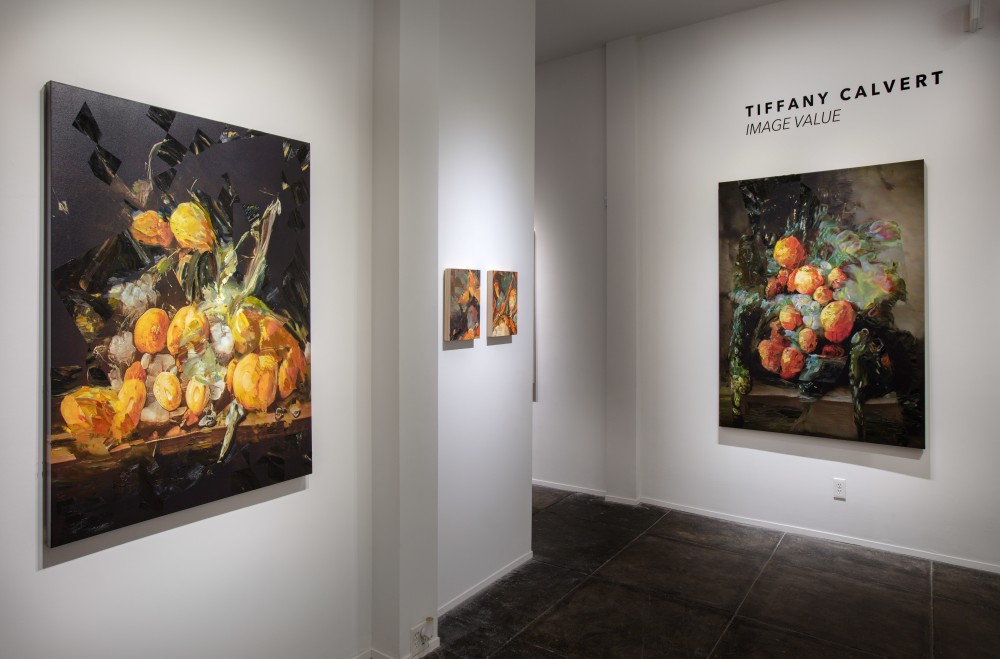
reviewed by Joe Craig
Tiffany Calvert – Image Value
on view until December 10th at Jonathan Ferrara Gallery.
400A Julia Street
New Orleans, LA 70130
Hours: Tuesdays – Saturday 10am – 5pm
In computer science, a value is defined as a unit of data that can be calculated or manipulated by a program. It can be a digit, a single letter, or a specific sequence of characters. When applied to images, every pixel is a unit of account containing the values that represent a block of color. Pattern recognition is achieved by interpreting average image values—extrapolating on these values and generating new graphic arrangements. Tiffany Calvert’s solo exhibition at Jonathan Ferrara takes its title from this term—Image Value—using machine learning to synthesize approximations of 17th-century Dutch still lifes. The artist prints these mutant compositions on canvas and embellishes the surface with swaths of impasto paint.
A blind read of Calvert’s work might presuppose that the artist is some variation of a still life painter, simply looking to continue the tradition with a newfangled flourish, which is what various gallery-goers assumed when interviewed at the opening. A closer examination reveals representational turmoil, where—in the case of Calvert’s #375—floral blooms become blurred and interspliced with mandarin globs, unrecognizable save the punch they pack. A strange transition of orange shapes occupies the bottom third of #375—an egg at the lower right-hand corner ascends leftward to a tangerine before shifting to a fragment that vaguely resembles a sideways fruit stem. These artifacts of misrepresentation are abundant in Calvert’s work—they highlight the contrast between the exacting nature of her source material (17th-century Dutch still lifes) and the slippery regurgitation of an underfed Artificial Intelligence (the machine learning model Calvert used was only trained on 1,007 images—a typical sample size is millions of images).
At base, a still life picture is a representation of objects which lack the ability to move, grouped into a composition. Tiffany Calvert takes this “unmoving model” of historical painting and feeds it back into the present with the aid of Artificial Intelligence. The resulting work is animated by its inconsistencies. In the passages marked by impasto paint, there is the pervading sense that the algorithm is being imbued with vitality—rising from the printed canvas into real life. Though even these small passages of material magic are not enough to make the picture whole—lodged in between the digital and the physical, the paintings feel Frankensteinian—an irreconcilable semblance of deformed parts. Two small paintings on view—#401 and #408—are able to juggle the tension of paint and reproduction, creating a field of entanglement where the figure and ground carry an equal amount of weight. These abstract puzzle pieces resist unravelment, their surfaces creating an airlock akin to the facets of a cut gem.
Calvert’s still lifes refuse to remain still—they feel fractured, ruptured by glitches—as if you dropped an electronic device and the image you were viewing was partially scrambled with smears of paint. Due to their compositional structure, the paintings impersonate classical still lifes, while at the same time eschewing settlement—weaving together a patchwork of signal and noise. Consider #383—a fiery sphere sits atop the painting, its implication as an orange secondary to the energetic expression it engenders. #383’s sphere refuses to remain static—it’s like a comet momentarily caught up in a bouquet—a triad of colors not unlike an alternate neopolitan ice cream, ranging from bright yellow and basketball orange to dirt brown. Occupying the middle-right is a bleary section of foliage—the border between paint and print becoming indistinct, as if a clear surface clouded from agitation of touch.
The source material the artist draws upon evinces the opposite of muddled expression. The majesty of 17th-century Dutch painting is evident in Abraham Mignon’s Fruchtschnüre an blauen Bändern (Strings of Fruit on Blue Ribbons). Its exemplification of bounty—not only in the form of flowers and fruit, but detail—showcases the precision and exacting approach employed by artists of the era (of which Mignon is a part). Mignon’s painting is an excellent training image due to its balanced proportions—its “almost symmetry”—same, but different—serves to underscore a rudimentary function of how machine learning can pick apart the relevant features of an image and recompose them in a way that reflects their original source. This reflective intelligence is at play in Calvert’s paintings—the conversation between herself and the algorithm is the catalyst for her art.
Her project is a grand collaboration between software engineers, Artificial Intelligence, and artist. An assortment of 17th-century Dutch and Flemish painters have unwittingly become participants in a generative gamble whose output is erratic—containing only traces of their original mastery. The remodeling of history is awash in Calvert’s work—a digital cauldron attempting to enliven a dusted corpse—it’s possible to view her paintings and corresponding source material on the internet, but her application of painterly finesse can only be fully appreciated in the flesh.
Tiffany Calvert applies contemporary painting techniques to historical imagery. Her recent work uses the seventeenth-century Dutch floral still life as a springboard for exploring the shifting nature of human perception.
Joe Craig is a writer interested in digital modes of artistic production. His work on Rembrandt’s Nightwatch—a painting of the Dutch Golden Age—can be found at https://joecraig.info/The_Night_Watch.html